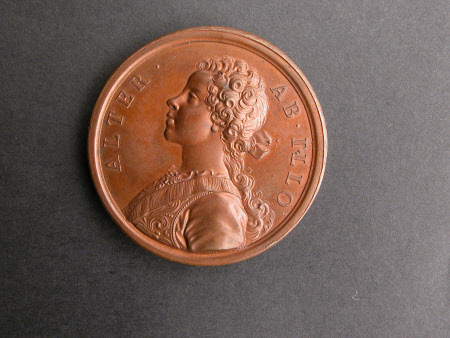Prince Charles Stuart and Prince Henry Stuart
Ottone Hamerani (1694 - 1761)
Category
Coins and medals
Date
1731 - 1732
Materials
Copper
Measurements
417 mm (Diameter)
Place of origin
Rome
Order this imageCollection
Osterley Park and House, London
NT 773304
Summary
Copper, medal of Prince Charles Edward Stuart (1720-1788) and his brother Prince Henry Benedict Stuart (1725-1807), by Ottone Hamerani (1694-1761), struck Rome, Italy, 1731-2. A copper medal of Prince Charles Edward Stuart and his brother Prince Henry Benedict Stuart by Ottone Hamerani struck in Rome in 1731-32. The obverse has a bust profile of the eleven-year old Charles facing right, dressed in armour with a lion pauldron and an ermine mantle. Before his face is a star, alluding to Charles’s princely origin, and referred to also in the Latin legend, ‘He shines in the midst of all’, taken from the Latin poet Horace’s Odes. On the reverse is a bust profile of the six year-old Prince Henry facing left, wearing an embossed breast plate, a riband across his breast, his hair long and tied in a bow at the neck. The Latin legend translates as ‘The next after him’ and the artist’s initial, H, is on the truncation. There is a further inscription on the edge, ‘On the 31st December 1720, he produced his sacred countenance from Heaven’, with a star.
Full description
The medal is a dynastic portrait of the two sons of Prince James Francis Edward Stuart, ‘The Old Pretender’ (1688-1766) and Princess Maria Clementina Sobieska (1702-35). The elder, Prince Charles Edward Stuart, became on his birth the great hope of the Jacobite movement, hence the suggestion in the legends on this and other medals (see NT 773303) of the role of Divine Providence in his birth. The quotation from Horace’s Odes on the obverse refers to the ‘Julian star’, a comet that was seen over Rome in 44 B.C., at the time that Octavian was holding games in honour of his assassinated adoptive father, Julius Caesar. The appearance of the comet was understood as providing proof of Julius Caesar’s divine status. Thus, the legend on the medal and the presence of the star suggest that, like Caesar, Prince Charles is divinely ordained to restore order to Britain. By the 1720s the Hanover kings seemed ever more firmly installed on the British throne, thus the birth of a new generation of potential Jacobite claimants represented a rare glimmer of hope for the cause. Prince Charles, ‘Bonnie Prince Charlie’ or ‘The Young Pretender’, would lead the attempted Jacobite invasion of 1745 which, with defeat at the Battle of Culloden on 16 April 1746, effectively snuffed out the last hopes for a Catholic Stuart restoration. Whereas Charles could never accept the reality of defeat, living out his remaining years consumed by bitterness, his younger brother Henry, like their father Prince James Edward Stuart, chose to reconcile himself to the course of events. Henry made a successful career in the Catholic Church, becoming a Cardinal (see NT 773275, 773313, 773315). It has been suggested (Woolf, The Medallic Record) that the medal was commissioned at the end of 1731 to commemorate Prince Charles’s eleventh birthday, on 31 December 1731, and that it was the medal mentioned in a letter of 12 March 1732 from the boys’ father Prince James to Francis Atterbury, Bishop of Rochester, enclosing a specimen of the piece, which he described as ‘my Childrens Medal’. The maker of the medal, Ottone Hamerani, signed a receipt on 5 January 1732 for payment for two gold and twenty silver medals of ‘the royal princes’ (‘delli Principi Reali’). Others must have been struck at other times, including those in copper. Hamerani made other medals for the exiled Stuart court, including the one to celebrate the birth of Prince Charles in 1720 (NT 773303). The Hamerani were a dynasty of engravers and medallists, originally from Germany, who settled in Rome in the 17th century. They were the principal die engravers and medallists in the city for some two hundred years. Jeremy Warren 2019
Provenance
Given to the National Trust in 1993 by George Child Villiers, 9th Earl of Jersey (1910-1998).
Marks and inscriptions
Obverse, legend: MICAT. INTER. OMNES Reverse, legend: ALTER. AB. ILLO. Reverse, on truncation: H Edge : DIE. XXXI. DECEMBR. MDCCXX. EXTVLIT. OS. SACRVM. COELO.
Makers and roles
Ottone Hamerani (1694 - 1761), medallist
References
Cochran-Patrick 1884: Robert William Cochran-Patrick, Medals of Scotland from the earliest period to the present time, Edinburgh 1884, pp. 69-70, no. 52, pl. XIII, Fig. 5. Hawkins, Franks and Grueber 1885: Edward Hawkins, Augustus W. Franks and Herbert A. Grueber (eds.), Medallic Illustrations of the History of Great Britain and Ireland to the death of George II, 2 vols., London 1885, pp. 492-93, no. 34. Woolf 1988: Noel Woolf, The Medallic Record of the Jacobite Movement, London 1988, p. 87, no. 43:1. Mitchiner 1988-2007: Michael Mitchiner, Jetons, Medalets and Tokens, 4 vols., London 1988-2007, vol. III (British Isles circa 1588 to 1830), 1998, p. 1739, no. 88.1 (5101). Guthrie 2009: Neil Guthrie, ‘Of Princes and Perukes: Jacobite Medals from 1731 to 1741’, The Medal, 55 (2009), pp. 23-32, pp. 24-27, fig. 1. Eimer 2010: Christopher Eimer, British Commemorative Medals and their Values, London 2010, p. 89, no. 521, pl. 62. Guthrie 2013: Neil Guthrie, The Material Culture of the Jacobites, Cambridge 2013, pp. 90-92.
